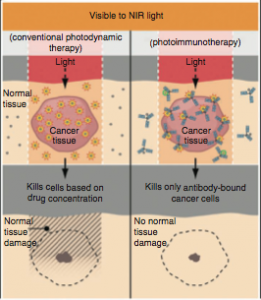Photoimmunotherapy may be a new way to deliver molecular-targeted cancer drugs
Photoimmunotherapy (PIT) that uses a near-infrared (NIR) dye conjugated to monoclonal antibodies (mABs) that target epidermal growth factor receptors (EGFR) is a new type of molecular-targeted cancer therapy that appears to offer considerable promise.
Research by Makoto Mitusnaga and colleagues from the Molecular Imaging Program at the National Cancer Institute (NCI) was published recently in Nature Medicine. This paper is well worth reading if you have an interest in this area.
The NCI researchers developed a:
“mAb-based photosensitizer that is activated by NIR light for targeted PIT only when bound to the target molecule on the cancer cellular membrane.”

I think this is exciting research because unlike conventional photodynamic therapy that also damages normal tissue, photoimmunotherapy kills only antibody-bound cancer cells with no normal tissue damage:
“Further, because this agent also emits a diagnostic fluorescence, it can be used to direct the application of light to minimize exposure to nonrelevant tissues and to noninvasively monitor any therapeutic effects of excitation light.”
You can read more in the Nature Medicine paper about this exciting research that may offer an innovative new drug delivery mechanism for targeted cancer therapies.
![]() Mitsunaga, M., Ogawa, M., Kosaka, N., Rosenblum, L., Choyke, P., & Kobayashi, H. (2011). Cancer cell–selective in vivo near infrared photoimmunotherapy targeting specific membrane molecules Nature Medicine DOI: 10.1038/nm.2554
Mitsunaga, M., Ogawa, M., Kosaka, N., Rosenblum, L., Choyke, P., & Kobayashi, H. (2011). Cancer cell–selective in vivo near infrared photoimmunotherapy targeting specific membrane molecules Nature Medicine DOI: 10.1038/nm.2554